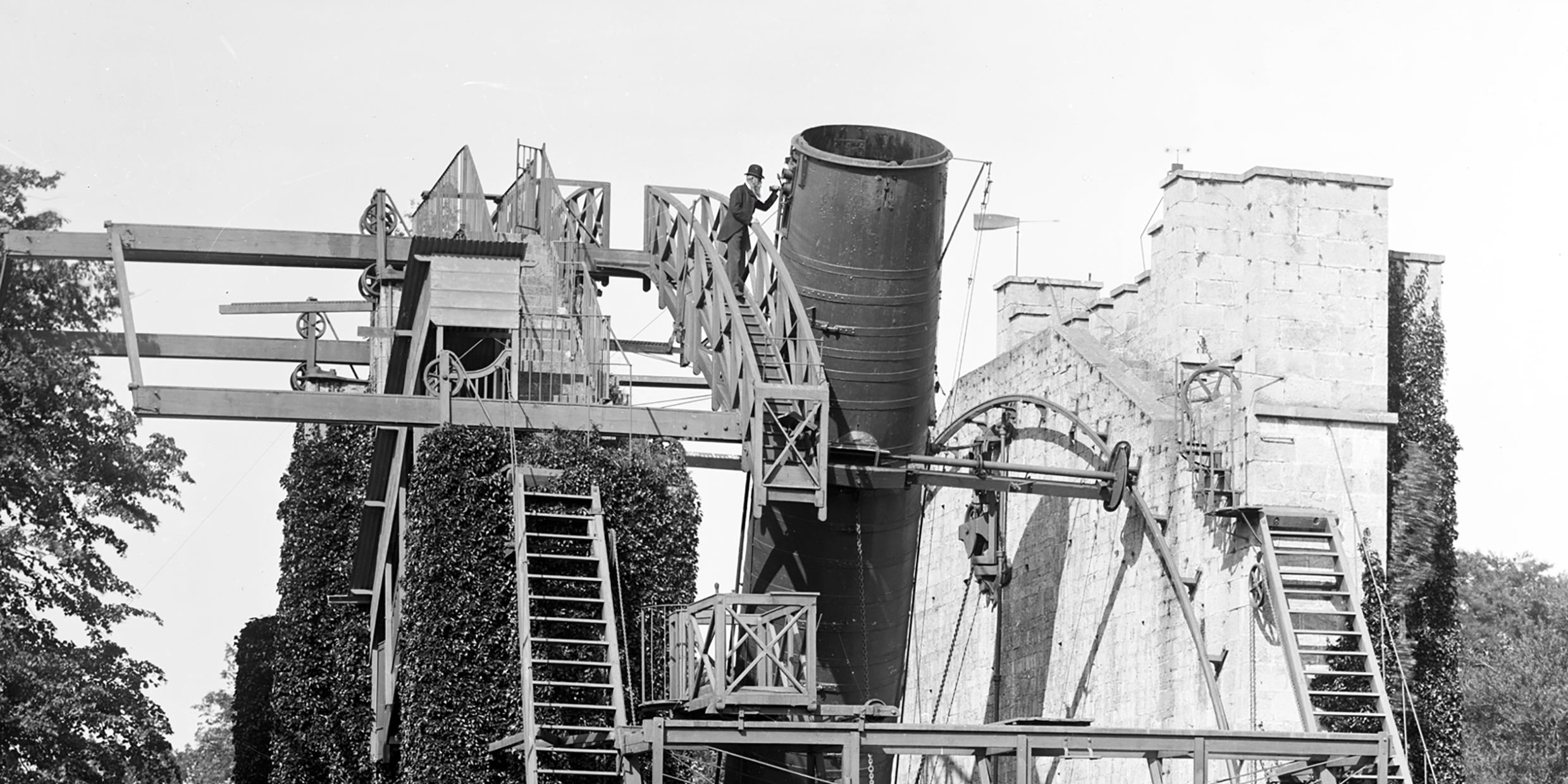Originally published 11 September 1995
Ireland — with its rag-wet skies, its one clear night in 10 — is no place to build an astronomical observatory. These days, astronomers go off to the Chilean Andes or Hawaii’s Mauna Kea to site their instruments in high, clear places thick with stars.
Ireland is no place to build an observatory, unless you happen to live there on a grand estate and have a passionate interest in the sky.
During the 1840s, William Parsons, 3rd Earl of Rosse and master of Birr Castle in the center of Ireland, constructed what was then, and would remain for three-quarters of a century, the world’s largest telescope.
The thing was a monster, an iron-hooped cylinder more than six feet in diameter hoisted between massive Gothic walls, with ladders and viewing galleries — a Big Bertha howitzer aimed at the stars. Visitors to the castle liked to have their pictures taken (by the earl’s wife Mary, a pioneer amateur photographer) standing in the gaping maw of the great tube.
The heart of the instrument was the “Great Speculum,” a metal mirror, six feet in diameter and weighing four tons, that gathered the light of distant objects and brought it to a focus. The disk was cast in a furnace constructed in the bottom of the castle moat, fired with turf from local bogs. Polished to a high brilliance, it was a wonder of Victorian science.
Astronomers from as far afield as the United States, Australia, and Russia came to Birr to see Lord Rosse’s leviathan of the cosmic deeps. One wonders how many of them managed to get a look at the stars, or went away cursing the Irish weather.
Rosse had the leisure to wait for clear nights, and when they came he went exploring.
He is best known for his discovery of the spiral nebula.
In 1845, he observed a pinwheel of light in the constellation Canes Venatici, under the handle of the Big Dipper. A luminous blur at this location was first cataloged by the French astronomer Charles Messier in 1773. Later, the astronomer Sir John Hershel examined the blur with an 18-inch telescope and detected a “very bright round nucleus surrounded at a distance by a luminous ring.” But it was Rosse’s 72-inch colossus that revealed the surprising and mysterious spiral.
The discovery of other celestial pinwheels soon followed.
At first the spiral nebulas were thought to be solar systems in the process of formation, out there among the stars. It wasn’t until the construction of the 100-inch telescope at Mt. Wilson in California, in 1923, that the spirals were determined to be other “island universes,” or galaxies.
We now call the object in Canes Venatici the “Whirlpool Galaxy.” Modern photographs show a dazzling double coil of tightly spiraling arms sprinkled with stars and streaked with dark lanes of dust.
The Whirlpool Galaxy is 15 million light-years distant and contains at least a hundred billion stars. It is very much like or own Milky Way Galaxy, from which it is receding at 340 miles per second as part of the general expansion of the universe. Tonight it will be 30 million miles farther away than last night, more than a trillion miles farther than it was when Rosse first sketched its pinwheel form.
All of the galaxies, except the very nearest, are speeding from us, hurtling into darkness, stretching and dimming their light, pulling the universe thin like taffy. Blasted outward by the violence of creation, they may continue to recede forever, or, if their mutual gravity is sufficient, snap back like the elastic-tethered ball of a bolo bat to re-create the Big Bang.
Those galaxies racing away into the night are not inert objects, like stones skipped on a pond. Surely they snap, crackle, and pop with life. Surely the stars of those other galaxies shimmer in their own green auras, their planets puffing with spores. The Whirlpool Galaxy is a prayer wheel spinning out our supplications to the dark abyss, an ark sailing into the possibly infinite cosmos with every creature two by two, born in fiery brilliance, heading toward a still uncertain fate.
This year [in 1995] we celebrate the 150th anniversary of Lord Rosse’s discovery of the spiral nebulas. At Birr, in Ireland, a $6 million campaign is under way to restore the great telescope and show it off, complete with staircases, chains, pulley systems and viewing galleries, as part of a Historic Science Center.
The Great Speculum is now in the Science Museum in London. When last I saw it there, it reposed in its reflective glory on a horizontal stand, like a magical Round Table from Camelot. Apparently, it is not yet certain whether it will be returned to Birr or replaced by a replica. It would be a shame if it is not rejoined with the restored instrument.
The Historic Science Center will celebrate Ireland’s many contributions to science (and will include Mary Rosse’s darkroom, the oldest still extant anywhere in the world). It will sit in the spectacular historic gardens of Birr Castle, which are themselves of considerable botanical interest. Few places on Earth so seamlessly join the beauties of life to the yawning infinities of the universe.



